In fact that pair of MAOPs should still be in Dave’s possession, and as I recall as with all over that series of drivers came with individual measurement printouts - perhaps he can dig them up and post them?
I used the instructions here to get a simulated response from an image of the frequency response and impedance curves published by Mark AudioAre these your own polar measurements or are they a Vituixcad simulation?
https://www.diyaudio.com/community/threads/vituixcad.307910/post-7027808
The frequency curve from Mark Audio also shows a big bump around 10kHz. This data is on-axis only and the off-axis data is simulated using VituixCad.FWIW, I owned a pair of MAOP7 for a couple years, I think it was, and in a couple of different enclosures never perceived anything approaching those graphs. To echo Allen’s query, when you say “tried”, does mean real world auditions, measurements, or simulations?
I understand I am using published data and not measured data but given the fact that I build a speaker only about once a decade, don't own these drivers and don't have the equipment or infrastructure to conduct frequency measurement tests (in open air or an anechoically dead room) the best I could do was used published data.
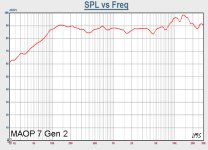
The off axis response should exhibit a lower peak than on axis. The on axis peak is there because the nature of a full ranger, is it beams at higher frequencies. If the on axis treble response was flat, the off axis treble would be very low.
Something is off with the simulation, in other words.
Something is off with the simulation, in other words.
I thought the 3k dip looked a bit too perfect.
With regards to this higher frequency issue at least, you could do your own polar measurements.
Vituixcad might not correctly simulate the part you're interested in. Simulations become productive once you understand their limitations and strengths. You should have been informed of these.the off-axis data is simulated using VituixCad.
With regards to this higher frequency issue at least, you could do your own polar measurements.
Apologies if I've missed this discussion already - does anyone have experience comparing chn50 to Alpair 5.3?
I'm looking to 'upgrade' to the Alpair in my SLOB WAW (acting as mid-tweeter), and wondering if the price jump is worth it?
I'm looking to 'upgrade' to the Alpair in my SLOB WAW (acting as mid-tweeter), and wondering if the price jump is worth it?
Fair enough.The off axis response should exhibit a lower peak than on axis.
Something is off with the simulation, in other words.
What would you reckon I did wrong? I did some more simulations and found that there are several woofers that might work well (or at least they will all work equally well) with the MAOP 7.

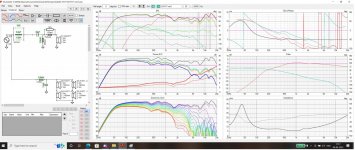
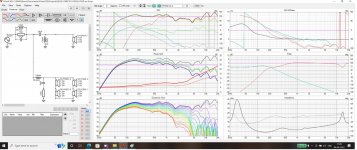
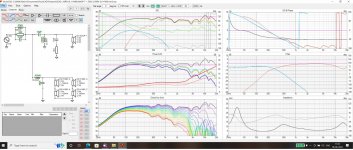
Do these look any better?
I thought the 3k dip looked a bit too perfect.
Vituixcad might not correctly simulate the part you're interested in. Simulations become productive once you understand their limitations and strengths. You should have been informed of these.
With regards to this higher frequency issue at least, you could do your own polar measurements.
My object with VituixCAD was only to determine which woofers if any will work well (or if there are several which would be the best choice) with the MAOP 7.
I currently have 4 candidates. All of them cost around $100-120 each.
SEAS L16RNX (1488)
SEAS U18RNX (1571)
SEAS U16RCY/P (1520)
SEAS L16RN-SL (1480)
I found that rolling the woofers off less steeply would give a better response on paper because the woofer's midrange response would fill the dip in the MAOP 7 on-axis response. However, given that the woofers are on the side walls of the cabinet I don't really like crossing them over too high. No simulation is going to simulate "side-mounted" woofers.
In my room, I have my speakers toed in towards the listening position as this is the most WAF option.
Which woofers to use? I'm not sure I see how vituixcad could help you find an answer to that? More or less all woofers will behave similarly when crossed low. (not talking about the obvious things like sensitivity) Also, different woofers can be forced to have the same response.
What do you think aboutRimligt nog.
Vad skulle du tro att jag gjorde för fel? Jag gjorde några fler simuleringar och fann att det finns flera bashögtalare som kan fungera bra (eller åtminstone kommer de alla att fungera lika bra) med MAOP 7.
View attachment 1061705View attachment 1061706View attachment 1061707View attachment 1061708
Ser dessa bättre ut?
Mitt syfte med VituixCAD var bara att avgöra vilka baselement om några som kommer att fungera bra (eller om det finns flera som skulle vara det bästa valet) med MAOP 7.
Jag har för närvarande 4 kandidater. Alla kostar runt 100-120 dollar styck.
SEAS L16RNX (1488)
SEAS U18RNX (1571)
SEAS U16RCY/P (1520)
SEAS L16RN-SL (1480)
Jag fann att en mindre brant rullning av bashögtalarna skulle ge bättre respons på papperet eftersom bashögtalarens mellanregistersvar skulle fylla sänket i MAOP 7-responsen på axeln. Men med tanke på att bashögtalarna sitter på sidoväggarna av skåpet gillar jag inte att korsa dem för högt. Ingen simulering kommer att simulera "sidomonterade" baselement.
I mitt rum har jag mina högtalare in mot lyssningspositionen eftersom detta är det mest WAF-alternativet.
Scan-Speak Discovery 22W/8534G00?
Thanks, Allen.Which woofers to use? I'm not sure I see how vituixcad could help you find an answer to that? More or less all woofers will behave similarly when crossed low. (not talking about the obvious things like sensitivity) Also, different woofers can be forced to have the same response.
Sensitivity (between F-10 and say 500Hz) was the primary concern since the design calls for 4 woofers to match with a single MAOP 7.
The other parameter was the response in an 11-12 litre bass reflex box (MLTL is an extrapolation/variation of a bass reflex box)for example from the drivers listed above the SEAS L16RN-SL H1480 (used by Linkwitz) prefers a box (QB3 alignment) that is about 25-28 litres.
The other question was how fast should these side-firing woofers roll-off? How high can we cross them and at what slope? Given that there are 4 of them flanking the full range (above and below and on both sides) would the sound emanating from them envelop the full range and how does this affect the response of the system. If we can cross them higher and gentler maybe the U18RNX/P H1520 and U16RCY/P H1571 might work better since they do not have any serious peaks in the upper-frequency response.
I tried researching this but found very little info.
Thanks, Leif, I haven't tried simulating this woofer. Based on the published T/S it might need a box larger than 11-12 litres.What do you think about
Scan-Speak Discovery 22W/8534G00?
Simulating side woofers may be an interesting challenge. So I'd ask the question, 'can it be done'... because if it can then you can build it, then measure to find out where to cross.
Kef does it, and some say it will be less than perfect. I think that with your own polar measurements, vituixcad could help you find a way to cross them. This doesn't include your house curve equalisation or room set up.
Kef does it, and some say it will be less than perfect. I think that with your own polar measurements, vituixcad could help you find a way to cross them. This doesn't include your house curve equalisation or room set up.
I would assume Dave (planet 10) would know because he has actually designed the Tysen V2 which uses a pair of woofers (in MLTL) flanking a full range (MidTL).Simulating side woofers may be an interesting challenge. So I'd ask the question, 'can it be done'... because if it can then you can build it, then measure to find out where to cross.
The closest I can come is something like this:
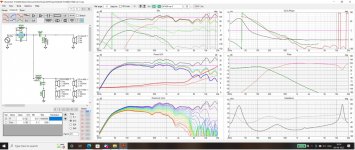
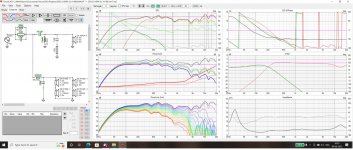
Not a huge difference between these 2 (and several others) which is what confuses me.
What I meant was, is it a viable design, are you confident enough it is something that can be done and you are willing to build it.
I don't feel vituixcad can fully simulate these. It would rather take your measurements and help you cross them.
I don't feel vituixcad can fully simulate these. It would rather take your measurements and help you cross them.
If I was confident I would be ordering drivers and building. The challenge I have is to order drivers from 8000 miles through custom duties and taxes without knowing if they will work. It's a bit of a chicken and egg syndrome.What I meant was, is it a viable design, are you confident enough it is something that can be done and you are willing to build it.
I don't feel vituixcad can fully simulate these. It would rather take your measurements and help you cross them.
Navin, it is hard to screw this up as long as things look close. Low XO eliminates many issues you usually have to deal with.
Be wary of analysis paralysis.
dave
Be wary of analysis paralysis.
dave
Navin, it is hard to screw this up as long as things look close. Low XO eliminates many issues you usually have to deal with.
Be wary of analysis paralysis.
dave
Thanks, Dave, for the confidence. I do eventually intend to go active (or PLL) using an integrated amplifier for the full range and a power amplifier for the bass. The integrated amplifier has both a "pre-out" which can be sent to a crossover and a "power in".
The driver I preferred (the SEAS L16RNX H1488) would have to be specially ordered for me by Madisound (3-4 month lead time). For some reason, no one seems to utilise this driver so Madisound rarely stocks more than 2. They do have adequate and regular stock of the L16RN-SL H1480. I suspect this is a special Sigfried Linkwitz version of the L16RNX H1488 for their LX series of speakers.
I ran simulations using both above in post #2091. I also ran simulations using 4 other 6-7" SEAS drivers (under $120 each) but prefer to use a metal cone since the MAOP 7 is also a metal cone and I believe the timber of an aluminium cone woofer would match the MAOP 7 better. The specifications of both the L16RNX and L16RN-SL are below.
https://www.madisoundspeakerstore.c...l16rnx-6-aluminum-cone-woofer-h1488-08-8-ohm/
https://www.madisoundspeakerstore.c...estige-l16rn-sl-h1480-5-aluminum-cone-woofer/
I am a little concerned about the L16RN-SL H1480 version since the Madisound recommendation is only for a sealed box (with its highish Qts of 0.46) and not for a vented box. Would this concern you?
Have you looked on SB drivers?Thanks, Dave, for the confidence. I do eventually intend to go active (or PLL) using an integrated amplifier for the full range and a power amplifier for the bass. The integrated amplifier has both a "pre-out" which can be sent to a crossover and a "power in".
The driver I preferred (the SEAS L16RNX H1488) would have to be specially ordered for me by Madisound (3-4 month lead time). For some reason, no one seems to utilise this driver so Madisound rarely stocks more than 2. They do have adequate and regular stock of the L16RN-SL H1480. I suspect this is a special Sigfried Linkwitz version of the L16RNX H1488 for their LX series of speakers.
I ran simulations using both above in post #2091. I also ran simulations using 4 other 6-7" SEAS drivers (under $120 each) but prefer to use a metal cone since the MAOP 7 is also a metal cone and I believe the timber of an aluminium cone woofer would match the MAOP 7 better. The specifications of both the L16RNX and L16RN-SL are below.
https://www.madisoundspeakerstore.c...l16rnx-6-aluminum-cone-woofer-h1488-08-8-ohm/
https://www.madisoundspeakerstore.c...estige-l16rn-sl-h1480-5-aluminum-cone-woofer/
I am a little concerned about the L16RN-SL H1480 version since the Madisound recommendation is only for a sealed box (with its highish Qts of 0.46) and not for a vented box. Would this concern you?
Actually, I haven't. Don't remember why.Have you looked on SB drivers?
There are 3 that might work.
SB17NRX2C35-8
SB17CAC35-8
SB17CRC35-8
of these, the NRX and CAC look more promising.
Thanks.
- Home
- Loudspeakers
- Full Range
- New Markaudio Drivers